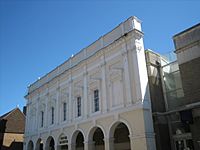Dover Museum facts for kids
 |
|
| Location | Dover, England |
|---|---|
Dover Museum is a cool place to visit in Dover, England. It's full of amazing history from this important port town. You can discover stories from ancient times right up to today!
Contents
Discovering Dover's Past
How the Museum Started
The Dover Museum first opened its doors in February 1836. Edward Pett Thompson, who was the mayor of Dover, helped start it. It began in an old building called the Guildhall. This was a place where town leaders met.
Later, the Town Council took over the museum. They built a brand new home for it in Market Square. This new building also had the town's market.
Surviving World War II
During Second World War in 1942, Dover was attacked from France. The museum was hit and lost many of its collections. Almost all of its natural history items were destroyed.
Many surviving pieces were hidden away in caves. They stayed there until 1946. Experts believe only about 30% of the museum's original collection survived the war.
In 1948, a temporary museum opened in the Town Hall. This "temporary" museum actually stayed open for a very long time! It wasn't until 1991 that a new, modern museum building opened. This new building had three floors and kept the old Victorian front.
A Special Boat and Awards
On July 20, 1999, the Queen herself opened a new gallery. This special part of the museum is all about the amazing Dover Bronze Age Boat. This boat is a very important discovery!
In December 2000, this gallery won a big award. It was recognized for helping us learn so much about archaeology. Archaeology is the study of human history through digging up old things.
What You Can See at Dover Museum
The museum has three floors packed with interesting exhibits. Here's a peek at what you can explore:
- Ground Floor: Archaeology Gallery
- This floor shows the history of Dover and the surrounding area. It covers times from prehistoric days up to 1066.
- You can see items from Roman and Saxon Dover. This includes finds from a Saxon cemetery.
- There's a cool model showing the Roman Emperor Claudius arriving in Britain. You can also see life-sized models of a Celt and a Roman!
- First Floor: Temporary Exhibitions
- This floor often changes! It hosts special shows for a limited time. You might see different themes and artifacts each visit.
- Second Floor: Dover's History and the Bronze Age Boat
- Learn about the history of Dover town itself. Discover its role in the Cinque Ports, a group of historic coastal towns.
- Explore the story of Dover Castle, a famous landmark.
- This floor also holds the incredible 2003 Dover Bronze Age Boat gallery. It's where you can see the actual boat and other treasures like the Langdon Bay hoard.
The White Cliffs Experience
The White Cliffs Experience was a visitor attraction next to Dover Museum. It opened in 1991. It aimed to show visitors what Dover was like in the past.
It had cool displays like a "Blitz Experience." This was an audio and visual show about World War II bombings. However, it didn't become as popular as hoped. It closed down in 1999.
Today, the building that housed the White Cliffs Experience is now the Dover Library and Discovery Centre. Some of the old displays, like the models, are now used in Dover Museum.
See also
- Dubris for Ancient Roman remains

